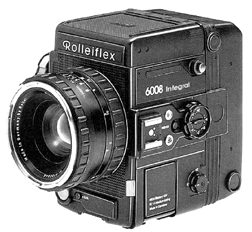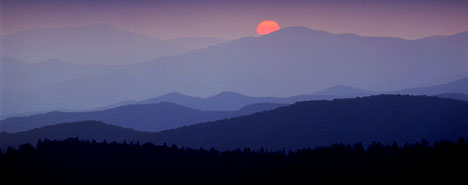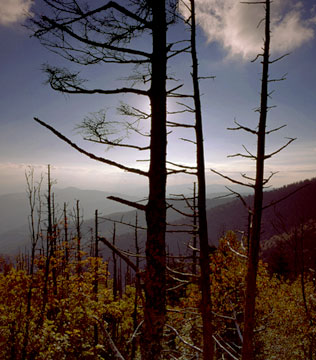Medium Format
Systems that I Own
Medium format is the Goldilocks of the camera world; not to big and not too small. 35mm excels in many areas including long lenses, high speed lenses, blazingly fast motor drives and exceptional autofocus, not to mention Image Stabilized lenses, and underwater housings. Large format excels in ultimate image quality and movements, though at the price of bulk and slow operation.
While I use 35mm gear extensively for those applications where its capabilities are required I don’t do much large format any more. The reason is that for any size enlargement that I care to make, medium format with today’s lenses and film offers exceptional image quality.
If you are new to the world of medium format and would like to learn more about what the jargon is all about and what other equipment is available, you may also enjoy my article on Understanding Medium Format.
Rollei 6008 Integral

The Rollei 6000 series of cameras is highly underrated in the North American environment. In Europe its popularity meets or exceeds that of Hasselblad. I regard the Rollei as the most innovative and more importantly useable 6X6 medium format camera on the market. There are 3 cameras in the line; the 6008 Integral, 6003 Professional and 6001. For more information have a look at the Rolleifoto web site. You can also explore the product line complete with prices at the B&H web site, though I highly recommend contacting Robert White in the UK for best pricing.
I am particularly partial to the 6X6 format for several reasons. While 645 cameras are somewhat smaller and lighter it is sometimes awkward to change from horizontal to vertical framing. With 6X6 you essentially have both orientations at the same time and the only real penalty is slightly higher film costs and a couple of less frames per roll. Also, I find that I frequently end-up framing and printing a square or almost square image — something that I find compositionally satisfying, especially when I’m also working with a panoramic camera at a particular location.
The Rollei has a number of built-in features that with other cameras are extras or add-ons. These include built in multi-pattern as well as spot metering (in the body, not the prism), and built-in motorized film advance. The interchangeable backs feature a built-in laminar dark slide (that can’t be lost or broken). The availability of inexpensive film inserts also makes rapid film changing a breeze.
The 6000 series Rollei cameras are remarkable in many ways. Not only is quality of construction and finish as fine as any camera ever made, but the design is ergonomically almost ideal. It has state-of-the-art automation features yet they never get in the way. Whether used at waist level or with an eye-level prism every control fall to hand.
If I sound enthusiastic, it’s because I am. Though I’ve had the system for several years I’m hard-pressed to think of a single thing that I’d add or subtract (except maybe some weight). Of course there’s no autofocus, but for landscape work it’s hardly needed, and with the investment that I now have in Schneider it glass would scarcely be worth considering.
In addition to a full range of Zeiss lenses, paralleling that available for the Hasselblad, the Rollei also features selected lenses from Schneider. I chose to go with the Schneiders and have 4 of them;
40mm f/3.5 Schneider Super Angulon
90mm f/4.0 APO Schneider Makro Symmar
180mm f/2.8 Schneider Tele-Xenar.
300mm f/4 Schneider Apo-Tele-Xenar
Without debating the relative merits of Schneider vs. Zeiss glass (angels on the head of a pin anyone?), I’ll simply say that these are among the finest lenses that I have ever used.
Sculptured Dunes — Death Valley CA, 1997
The 40mm is small and light weight, and due to its floating element design is tack sharp from closest focusing distance to infinity. A great landscape lens.
The 90mm APO is the jewel of the collection. Reputed to be one of the sharpest medium-format lenses ever, (I’ve heard the same thing said about the 80mm f/2.8 Nikkor that was used on the Plaubel Makina 670), the Schneider focuses down to‚¬º life size without an external tube. I sometimes wish I had a “normal” focal length f/2.8 lens, or even an f/2.0, but if it comes to a trade-off between speed and resolution I’ll take what Schneider makes any time.
The 180mm Tele-Xenar is a brute, weighing about 4lbs. It adds real weight and bulk to my equipment bag. But it is my most used focal length for landscape work and because it is a fast f/2.8 is easy to focus in low light.
The300mm Apo-Tele-Xenaris, as one might expect, a critically sharp lens and its size is manageable given its focal length and aperture. My only concern is that the lens’ tripod mount is not placed at its point of balance when a camera is mounted. The combined weight is low enough that an Arca Swiss B1 ball-head on a Gitzo carbon fiber tripod is a stable mount. But, because of the off-center weighting there is a noticeable pendulum effect caused by mirror slap. I consequently do not use the lens’ shoe tripod mount and instead simply mount the camera on the tripod. Results have been excellent since I almost always shoot using mirror pre-release and since the Rollei’s electromagnetic leaf-shutters are essentially vibrationless.
When the 300mm is combined with the 2X extender it creates a 600mm f/8, ideal for the kind of detail extraction that I enjoy doing in landscape photography. Stopping down 2 stops from wide open for best results means working at an effective f/16, but for landscape extraction this isn’t a problem. The lens was my most recent addition and was baptized during a shoot in October ’99 in the Eastern Sierras. More than 50% of the successful photographs from that trip were taken with the 300mm, a testament to how well it matches my way of seeing. It has seen extensive use since.
Clingmans Dome Sun. Great Smoky Mountains NP. September, 2000
Photographed with a Rollei 6008 and 300mm SchneiderApo-Tele-Xenaron Provia 100F.
Note:The July 1999 issue of Popular Photography (Volume 63, No. 7) has a highly favourable review of the Rollei 6008, the Schneider 90mm APO Makro, and several Zeiss lenses as well.
The Rollei 6008 is one of those rare hybrids that usually works equally well in the field as well as in the studio. Many 120 roll-film cameras are well suited to the rigors of the studio but then are out of their element on a mountainside at 11,000 feet on a -5C morning when the snow is howling. After yet another successful field trip with the Rollei system my appreciation for its capabilities are again reinforced.
![]() December, 2001: While the Rollei continue to provide superb images, I have found over the past few years that it can be a bit fickle when the weather turns very damp. Not the ideal camera for shooting in the rainforest.
December, 2001: While the Rollei continue to provide superb images, I have found over the past few years that it can be a bit fickle when the weather turns very damp. Not the ideal camera for shooting in the rainforest.
One of the things that I appreciate most about the 6008 (and many of these comments apply to the 6003 and 6001 as well), is the ergonomics. Whether tripod mounted with a waist-level finder or hand-held with an eye-level prism, the camera’s controls always seem to fall-to-hand. This is due in part to having all major features built-in rather than as add-ons. This includes metering and motor-drive.
The metering is simply superb, featuring multi-segment, true spot and multi-spot capabilities. The built-in dark-slide means never sitting on a slide accidentally or dropping it in the snow or mud. The rechargeable Nicad batteries slide in and out with a single finger which makes changing them in arctic conditions quick and straightforward. (Nicad batteries also have the best cold-weather characteristics of any type of battery except lithiums).
The automation couldn’t be easier to use. The lens’ aperture ring has anAutomatic position as does the shutter-speed dial. For shutter-preferred exposure automation set the lens to A and aperture-preferred automation set the shutter-speed dial toA. For full automation place both on A. How logical.
The viewfinder has extensive read-outs keeping you informed of all functions. I particularly like the electric remote cable that allows you to pre-release the mirror with one button and then trip the shutter with another.
![]() February, 2002
February, 2002
Though I produced a large number of first-rate images with it, after about 5 years of owning my Rollei 6008 system I sold it in early 2002. Why? I love the Rollei’s ergonomics and lenses. Probably as good as it gets in both departments. But, I have found it to have a few issues that were getting in the way of the kind of field work that I am increasingly doing.
These issues include the nicad batteries. I can’t use a rechargeable battery dependent camera like the Rollei on shoots where I am away from AC power for up to a week at a time. During 2001 I did two expeditions where this was the case, and expect to do more in the years ahead.
As noted above, the camera is very sensitive to water. I’ve had it fail on me a couple of times in heavy rain. It always returns to operation when dried, but the electronics are a bit finicky in this regard. Most people won’t encounter these problems, but for rugged outdoor use (I now now am doing more wildlife shooting), the 6008 leaves something to be desired.
The longest lens that is readily available is 300mm. There are several longer lenses available for the Pentax medium format cameras, and as mentioned since I am doing an increasing amount of medium format wildlife work this has become quite important to me.
I have therefore switched to the Pentax 67 and 645 systems. Since these two bodies can share a range of lenses I now have a versatile field system that better meets my needs. (See links below to reviews of both of these cameras). Of course this is going to cause some folks to ask, is the Pentax better than the Rollei? The answer is “no”, it’s just different, and the difference are what make it more suitable for me for the types of shooting that I do. Your uses and needs may be quite different.
Ps: I miss my Rollei system.
Mamiya 645 Pro
For a time before switching to the Rollei 6008 I had a Mamiya 645 system. The switch had more to do with wanting to work in 6X6 again, (I used Hasselblad extensively for many years in my pro days), rather than any dissatisfaction with the Mamiya. I found the Mamiya lenses to be generally quite good, though not in the same league as Zeiss or Schneider glass.
Plaubel Makina 670
Imagine a cross between a Mamiya 7 and a Fuji GA645 folding camera. During the mid-1980’s the Plaubel Makina 67 and 670 (with wide-angle variants) offered a relatively compact 6X7 format rangefinder camera with built-in meter.
Its main claim to fame was the 80mm f/2.8 Nikkor lens fitted. It was really spectacular. I owned a 670 for quite a few years and it produced exceptional results. Its Achilles heel was the folding mechanical strut construction, which was a bit less robust than it should have been.
I eventually sold it to finance the purchase of my Rollei 6008 system and have regretted the loss ever since. Now, they have become collector items and command fairly high prices when found in top condition. Since I’m a user rather than a collector of cameras I’m not tempted to find another, but I’ll always have fond memories of this great camera.
A viewcamera that you can hold in the palm of your hands. This exciting camera system is not inexpensive, but it offers a unique solution for medium format landscape photographers in search of movements for perspective control. An ideal field camera for backpackers.
Clingmans Dome Forest. Great Smoky Mountains NP. September, 2000
Photographed with a Hasselblad ArcBody and 45mm Rodenstock lens on Provia 100F.
For about a year I used a Mamiya 7II as a hiking camera. While it’s a fine system it didn’t work out for me and my application. This site has a review by Jack Zyberk and also a field report written by me.
![]() December, 2001
December, 2001
My new love is the Pentax 67II. This has quickly become my preferred system for backpacking and extended trips away from AC power, where the Rollei’s dependence on rechargeable batteries becomes a liability. It also excels in medium format long lens work.
![]() January, 2002
January, 2002
The new 645NII entered my arsenal as a second body for my Pentax 67 system. But very quickly I bought a number of autofocus lenses for it and it now serves as a lightweight medium format system for personal travel.
If you are new to the world of medium format and would like to learn more about what the jargon is all about and what other equipment is available, you may also enjoy my article on Understanding Medium Format.
If you enjoyed this article, as well as the hundreds of other tutorials, features,
reviews and essays on this site, you can support its continued growth
and discover an exciting new photographic resource by …
You May Also Enjoy...
Emperor
The Emperor's New Clothes Believing Ones Own Eyes Every now and then I write something that gets people's hackles up. Usually it's when I


